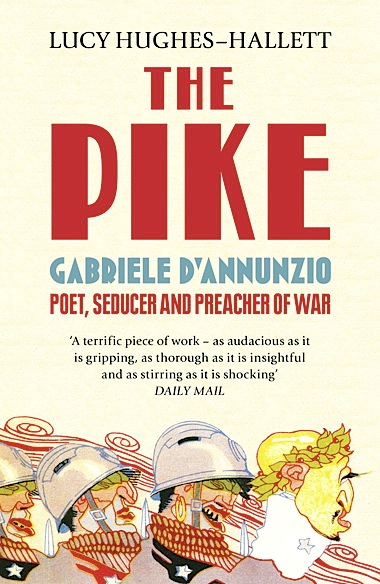Reviewed by Charles Freeman, historical consultant to the Blue Guides:
Lucy Hughes-Hallett’s The Pike is a long (644 pages of text) biography of the extraordinary Italian poet, and—well one can hardly begin to say what else—Gabriele d’Annunzio. The only thing that disappointed me about it was its title. Although this was indeed a nickname given to d’Annunzio, ‘Pike’ suggests a cunning fish lurking in the weeds before rushing out to snap up its prey. But d’Annunzio was an extrovert superstar, flourishing through his poetry and plays and flamboyant gestures, not least his lording over the Italian seizure of Fiume at the end of the First World War. He emerged young in the 1890s as a poet of great sensitivity, whose works still resonate among Italian nationalists. Yet his early works also show an obsession with the ‘heroic’ individual, a composite figure that owed as much to his personal frustrations as to Nietzsche. D’Annunzio had a genius for sniffing the emotional currents that swept through an emerging and unfulfilled nation and so was idolized by the young. Condemnation by the Church for the immorality of his ‘heroes’ simply added to his appeal.

The many ambiguities of d’Annunzio arise not only because of his supreme talent in the use of words. He was also a man of courage whose survival from a number of dramatic flights in the rickety planes of the early 20th century can only be seen as miraculous. Again he was totally unscrupulous in his extraordinary extravagance and insatiable sex-life. Women found him impossible to resist. At first he appeared to specialise in entanglements with the separated wives of minor aristocrats, to the fury of their fathers and husbands. The most successful love of his life, almost a permanent relationship, in fact, was with the actress Eleanor Duse, whom he romantically met in Venice on a gondola at dawn. Each had an utter confidence in their own genius that sustained the heights of their passion—and inspired d’Annunzio to become a dramatist. By the time of his literary success, however, there was little room for fidelity: new lovers were passing through beds still warmed by their predecessors. His hyped-up literary style was employed to full effect in describing the intimate details of these encounters, which took place in over-heated houses furnished with an overload of flowers, Persian carpets, Japanese porcelain and a large and well-thumbed library. D’Annunzio was as gargantuan in his ability to devour books as he was to devour women. Bailiffs cleared everything out from time to time until a fresh influx of cash allowed him to restock his villas with new purchases.
By the beginning of the First World War, d’Annunzio had developed an unhealthy obsession with the glory of death in the cause of Italy. In a less troubled age, it would hardly have resonated but once again he caught the mood, and must be partly held responsible for forcing Italy’s disastrous entry into the war. Scouring the battlefront on the Karst, the limestone plateau north of Trieste that was to see the pitiless slaughter of the ill-prepared Italian army, he revelled in the piled corpses. There was not much here to achieve other than swooping about in aircraft. It was the truncated peace that gave him his opportunity to find a role. The refusal to allow Italy to spread into the new Yugoslavia allowed him to seize control as dictator of Fiume. In the short term this was the culmination of his career, but it was a success that was gradually dissipated through his administrative incompetence and the seeping away of any international support for Italy’s expansion. His bluster proved to be just that. But it was here, in the frustrations of failure, that fascism was able to get a hold. Hughes-Hallett brings out an unexpected side of Mussolini, who showed surprising skill in flattering and cajoling d’Annunzio while at the same time sidelining him. There is a good photograph of the two walking together, d’Annunzio stooped (but still sexually insatiable) in the park of the Villa Cargnacco on Lake Garda (whose upkeep and expansion by the state he had persuaded Mussolini to finance). Here eventually, apparently to the vast relief of Mussolini, who knew that d’Annunzio was the only person able to upstage him, the heroic poet died in 1938.
D’Annunzio should, of course, have died many years before during one of his escapades in the air, in the crush of a tumultuous crowd or at the hands of an outraged husband. But he survived and his readiness to write down almost every detail of his daily life as well as the enormous publicity every action of his generated have given Hughes-Hallett vast resources to draw on. She has handled them with aplomb and has achieved the remarkable feat of showing that this was a human being whose life seemed to defy reality. The Pike was a worthy winner of this year’s Samuel Johnson Prize for Non-Fiction.






